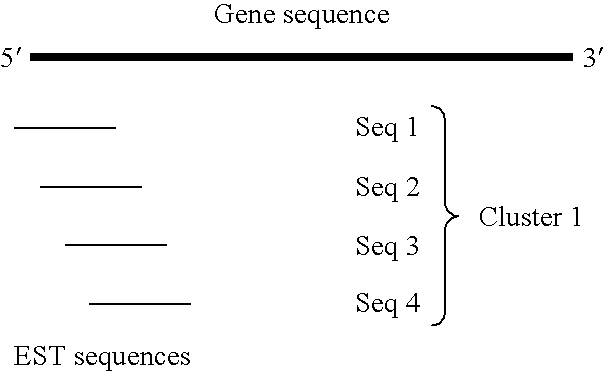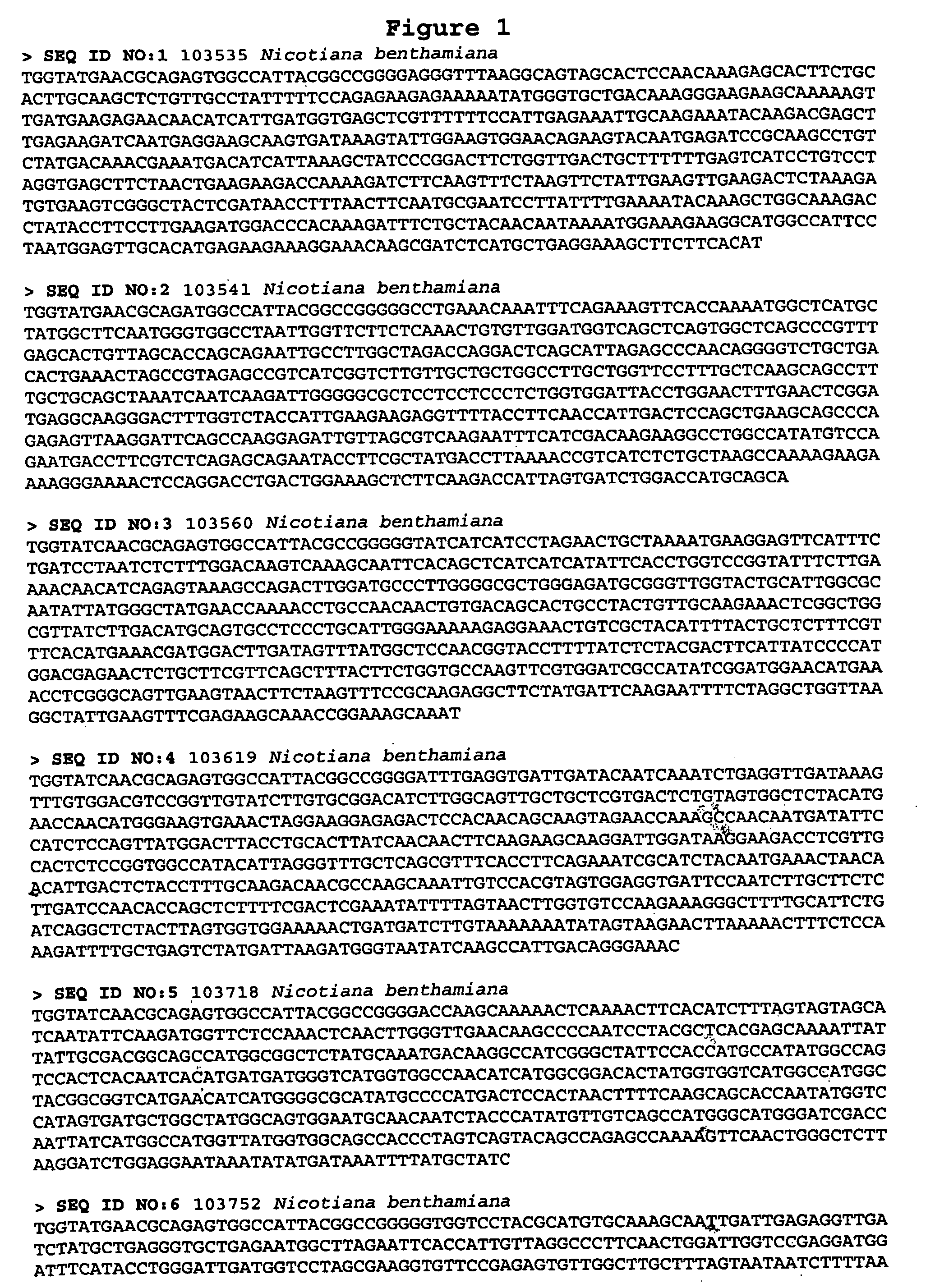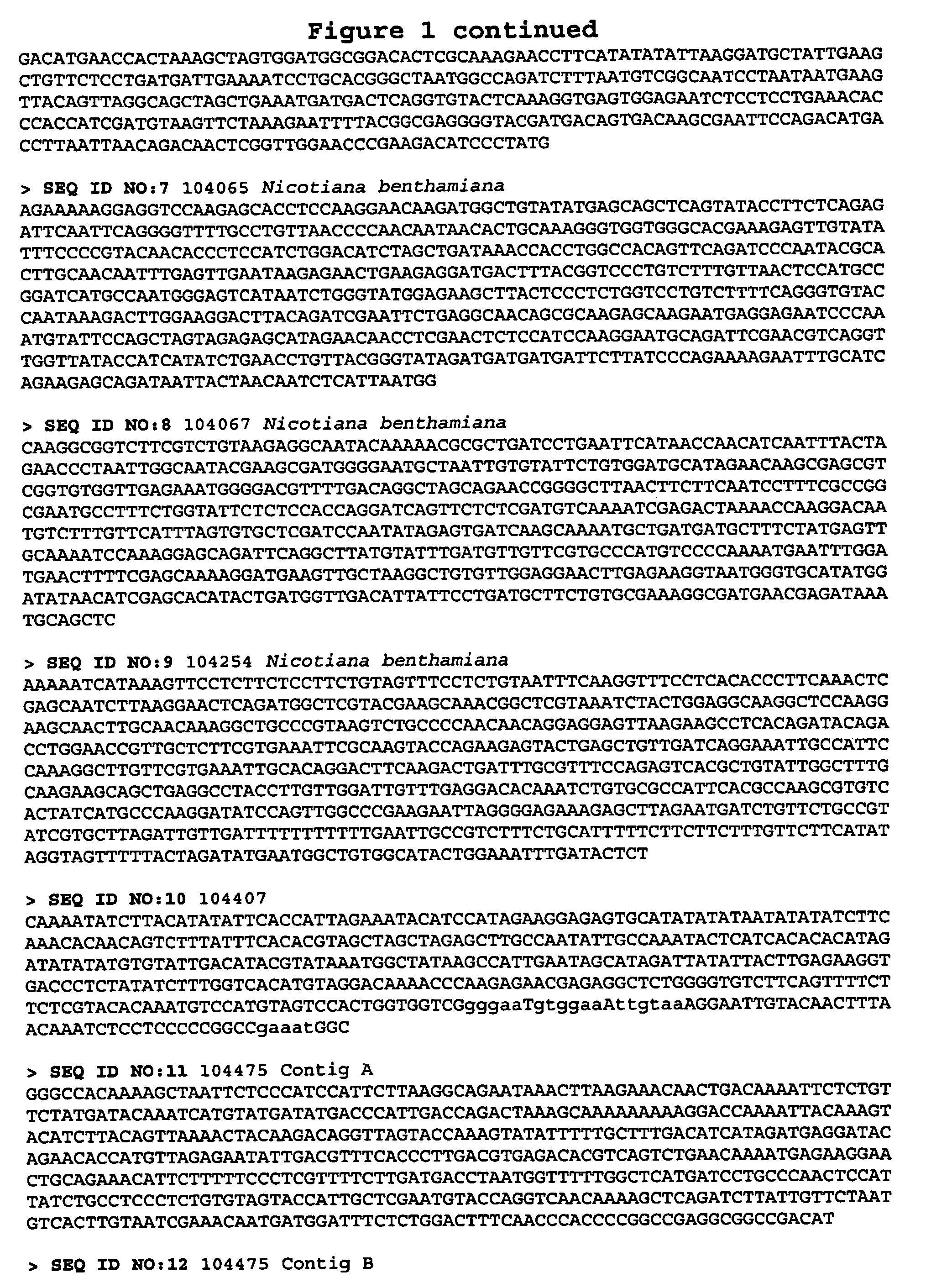Nucleic acid compositions conferring altered metabolic characteristics
a technology of nucleic acid composition and metabolic characteristics, which is applied in the field of deoxyribonucleic acid (dna) and amino acid sequences, can solve the problems of time-consuming and slow identification of genes with truly profound effects on the production of desired compounds by plants, and achieve the effect of low stringency and altered metabolism
- Summary
- Abstract
- Description
- Claims
- Application Information
AI Technical Summary
Benefits of technology
Problems solved by technology
Method used
Image
Examples
example 1
Construction of Tissue-specific N. benthamiana cDNA Libraries
[0262] A. mRNA Isolation: Leaf, root, flower, meristem, and pathogen-challenged leaf cDNA libraries were constructed. Total RNA samples from 10.5 μg of the above tissues were isolated by TRIZOL reagent (Life Technologies, Inc.; Rockville, Md.). The typical yield of total RNA was 1 mg PolyA+RNA and was purified from total RNA by DYNABEADS oligo (T)25. Purified mRNA was quantified by UV absorbance at OD260 The typical yield of mRNA was 2% of total RNA. The purity was also determined by the ratio of OD260 / OD280. The integrity of the samples had OD values of 1.8-2.0.
[0263] B. cDNA Synthesis: cDNA was synthesized from mRNA using the SUPERSCRIPT plasmid system (Life Technologies, Inc.; Rockville, Md.) with cloning sites of NotI at the 3′ end and SalI at the 5′ end. After fractionation through a gel column to eliminate adapter fragments and short sequences, cDNA was cloned into both GENEWARE™ vector p1057 NP and phagemid vector...
example 2
Construction of Normalized N. benthamiana cDNA Library in GENEWARE™ Vectors
[0265] A. cDNA synthesis. A pooled RNA source from the tissues described above was used to construct a normalized cDNA library. Total RNA samples were pooled in equal amounts first, then polyA+RNA was isolated by DYNABEADS oligo (dT)25. The first strand cDNA was synthesized by the Smart III system (Clontech; Palo Alto, Calif.). During the synthesis, adapter sequences with Sfi1a and Sfi1b sites were introduced by the polyA priming at the 3′ end and 5′ end by the template switch mechanism (Clontech; Palo Alto, Calif.). Eight μg first strand cDNA was synthesized from 24 μg mRNA. The yield and size were determined by UV absorbance and agarose gel electrophoresis.
[0266] B. Construction of Genomic DNA driver. Genomic DNA driver was constructed by immobilizing biotinylated DNA fragments onto streptavidin-coated magnetic beads. Fifty μg genomic DNA was digested by EcoR1 and BamH1 followed by fill-in reaction using ...
example 3
Rice cDNA Library Construction in GENEWARE™ Vectors
[0271]Oryzae sativa var. Indica IR-7 was grown in greenhouses under standard conditions (12 / 12 photoperiod, 29° C. daytime temp., 24° C. night temp.). The following types of tissue were harvested, immediately frozen on dry ice and stored at −80° C.: young leaves (20 days post sowing), mature leaves and panicles (122 days post sowing). Mature and immature root tissue (either 122 or 20 days post sowing) was harvested, rinsed in ddH2O to remove soil, frozen on dry ice and stored at −80° C.
[0272] The following standard method (Life Technologies) was used for generation of cDNA and cloning. High quality total RNA was purified from target tissues using Trizol (LTI) reagent. mRNA was purified by binding to oligo (dT) and subsequent elution. Quality of mRNA samples is essential to cDNA library construction and was monitored spectrophotmetrically and via gel electrophoresis. 2-5 μg of mRNA was primed with an oligo (dT)-NotI primer and cDNA...
PUM
| Property | Measurement | Unit |
|---|---|---|
| Temperature | aaaaa | aaaaa |
| Temperature | aaaaa | aaaaa |
| Temperature | aaaaa | aaaaa |
Abstract
Description
Claims
Application Information
 Login to View More
Login to View More - R&D Engineer
- R&D Manager
- IP Professional
- Industry Leading Data Capabilities
- Powerful AI technology
- Patent DNA Extraction
Browse by: Latest US Patents, China's latest patents, Technical Efficacy Thesaurus, Application Domain, Technology Topic, Popular Technical Reports.
© 2024 PatSnap. All rights reserved.Legal|Privacy policy|Modern Slavery Act Transparency Statement|Sitemap|About US| Contact US: help@patsnap.com










